lock AUDI TT COUPE 2016 Service Manual
[x] Cancel search | Manufacturer: AUDI, Model Year: 2016, Model line: TT COUPE, Model: AUDI TT COUPE 2016Pages: 322, PDF Size: 52.86 MB
Page 187 of 322
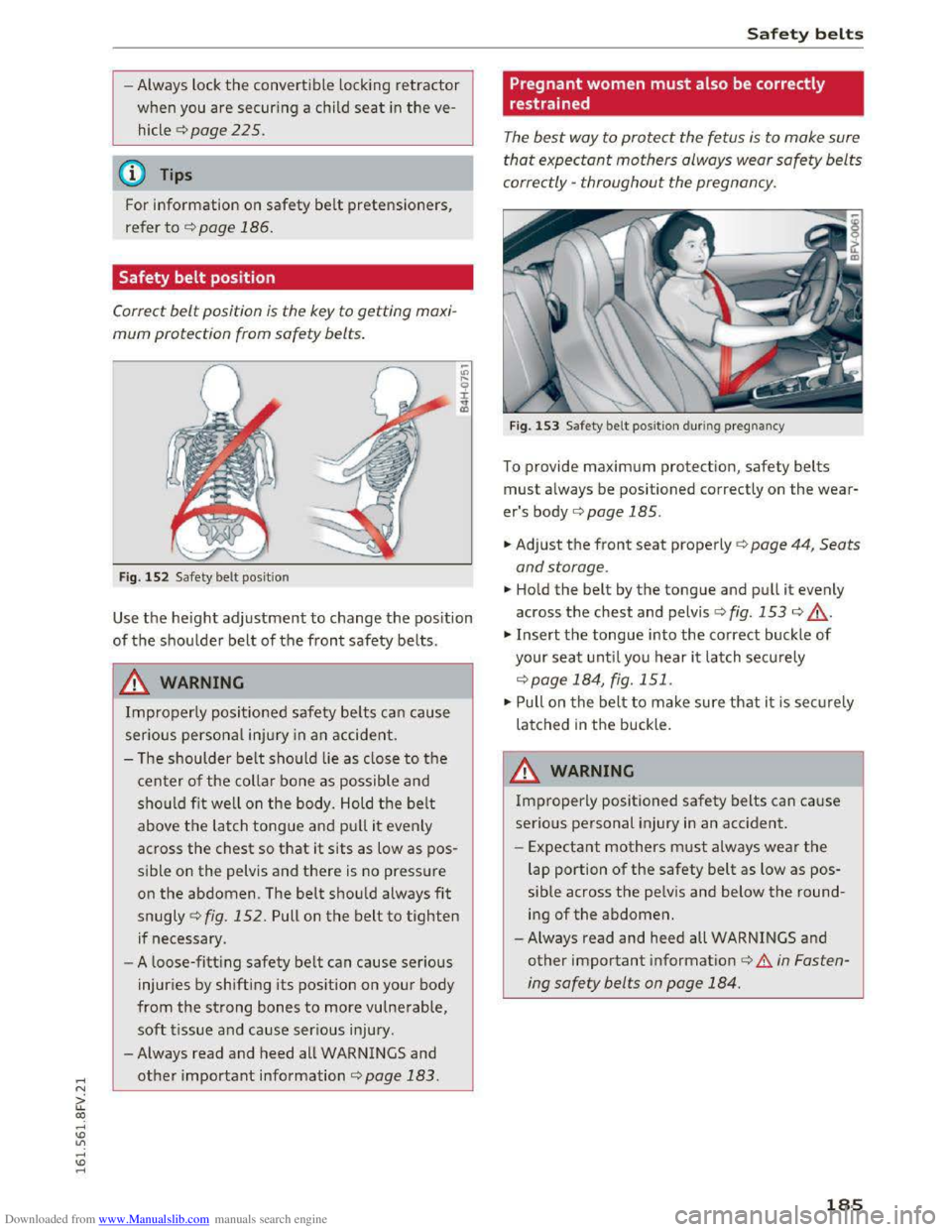
Downloaded from www.Manualslib.com manuals search engine .... N
G: CX)
....
"' U"I
....
"' ....
-Always lock the convertible locking retractor
when you are securing a child seat in the ve
hicle
¢ page 225.
@ Tips
For information on safety belt pretensioners,
refer to ¢page 186.
Safety belt position
Correct
belt position is the key to getting maxi
mum protection from safety belts.
Fig. 152 Safety belt positio n
-"' .... 9 I
"' al
Use the height adjustment to change the position
of the shoulder belt of the front safety belts.
_&WARNING
Improperly positioned safety belts can cause
serious personal injury in an accident.
- The
shoulder belt should lie as close to the
center of the collar bone as possible and
should fit well on the body. Hold the belt
above the latch tongue and pull it evenly
across
the chest so that it sits as low as pos
sible
on the pelvis and there is no pressure
on the abdomen. The belt should always fit
snugly¢ fig. 152. Pull on the belt to tighten
if necessary.
- A loose-fitting
safety belt can cause serious
injuries by shifting its position on your body
from the strong bones to more vulnerable,
soft tissue and cause serious injury.
- Always
read and heed all WARNINGS and
other important information ¢page 183 .
Safety belts
Pregnant women must also be correctly
restrained
The best way to protect the fetus is to make sure
that expectant mothers always wear safety belts
correctly
-throughout the pregnancy.
Fig. 153 Safety belt position duri ng pregnancy
To provide maximum protection, safety belts
must always be positioned correctly on the wear
er's body ¢page 185 .
... Adjust the front seat properly ¢ page 44, Seats
and storage .
... Hold the belt by the tongue and pull it evenly
across the chest and pelvis ¢ fig. 153 ¢ ..&_.
.,. Insert the tongue into the correct buckle of
your seat until you hear it latch securely
¢page 184, fig. 151 .
... Pull on the belt to make sure that it is securely
latched in the buckle.
_&WARNING
Improperly positioned safety belts can cause
serious personal injury in an accident.
- Expectant
mothers must always wear the
lap portion of the safety belt as low as pos
sible across the pelvis and below the round
ing
of the abdomen.
- Always read and heed all WARNINGS and
other important information c> .&. in Fasten
ing safety belts on page 184.
185
Page 194 of 322
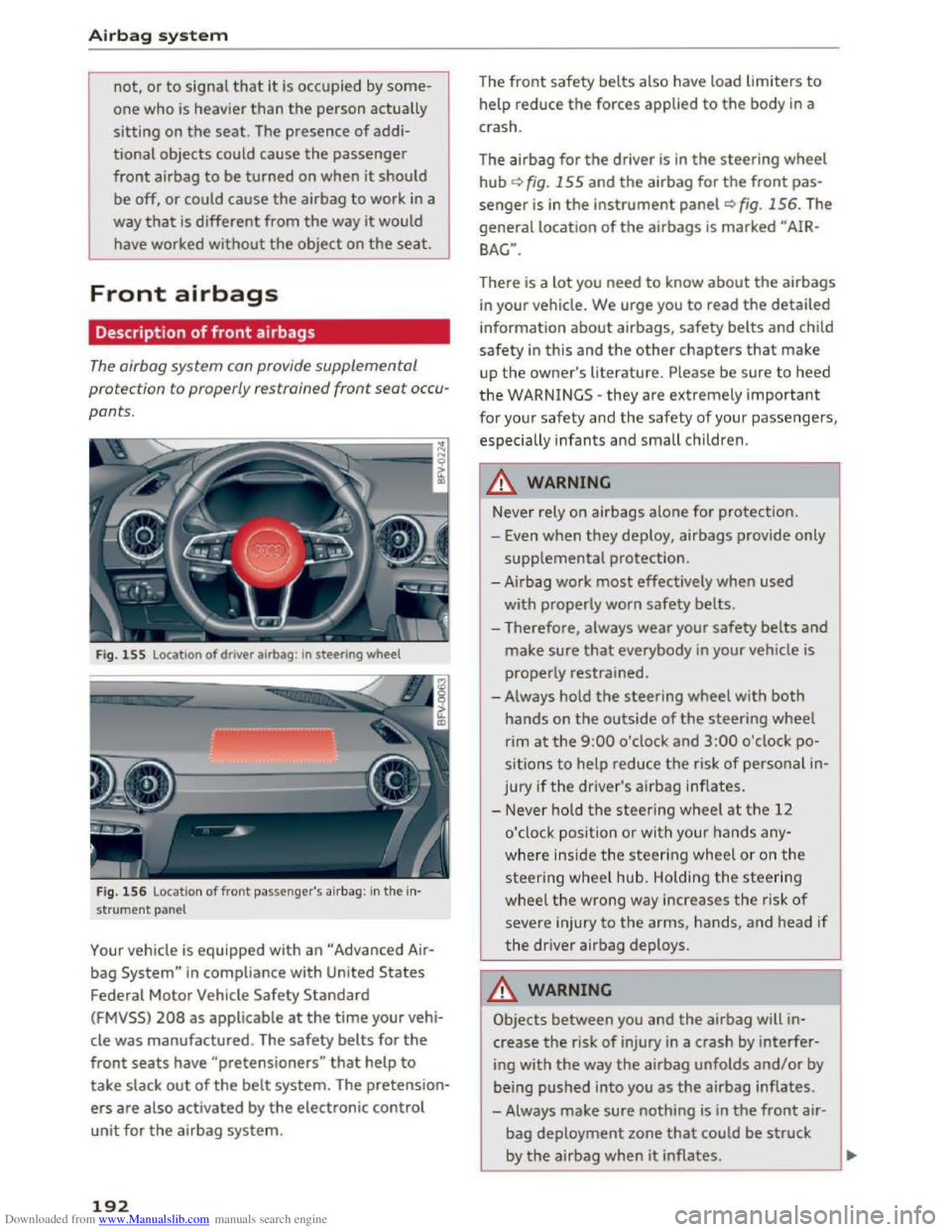
Downloaded from www.Manualslib.com manuals search engine Airbag system
not, or to signal that it is occupied by some
one who is heavier than the person actually
sitting on the seat. The presence of addi
tional objects could cause the passenger
front airbag to be turned on when it should
be off, or could cause the airbag to work in a
way
that is different from the way it would
have worked
without the object on the seat.
Front airbags
Description of front airbags
The airbag system can provide supplemental
protection to properly restrained front
seat occu
pants.
Fig. 155 Locat ion of driver airbag : in steering wheel
Fig.
156 Location of front passenger's airbag: in the in·
strument panel
Your vehicle is equipped with an "Advance d Air
bag System" in compliance with United States
Federal Motor Vehicle Safety Standard
(FMVSS) 208 as applicable at the time your vehi
cle
was manufactured. The safety belts for the
front seats have "pretensioners" that help to
take slack out of the belt system. The pretension
ers are also activated by the electronic control
unit for the airbag system.
192
The front safety belts also have load limiters to
help reduce the forces applied to the body in a
crash.
The airbag
for the driver is in the steering wheel
hub i::> fig. 155 and the airbag for the front pas
senger is in the instrument panel i::> fig. 156. The
general location of the airbags is marked "AIR
BAG".
There is a lot you need to know about the airbags
in your vehicle. We urge you to read the detailed
information about airbags, safety belts and child
safety in this and the other chapters that make
up the owner's literature. Please be sure to heed
the WARNINGS -they are extremely important
for your safety and the safety of your passengers,
especially infants and small children .
_&WARNING
-
Never rely on airbags alone for protection.
- Even when they deploy, airbags provide only
supplemental protection.
-Airbag work most effectively when used
with properly
worn safety belts.
- Therefore, always
wear your safety belts and
make sure that everybody in your vehicle is
properly
restrained.
- Always hold the steering wheel with both
hands on the outside of the steering wheel
rim at the 9:00 o'clock and 3:00 o'clock po
sitions
to help reduce the risk of personal in
jury if the driver's airbag inflates.
-Never hold the steering wheel at the 12
o'clock position or with your hands any
where inside the steering wheel or on the
steering wheel hub. Holding the steering
wheel the wrong way increases the risk of
severe injury to the arms, hands, and head if
the driver airbag deploys.
_&WARNING
Objects between you and the airbag will in
crease the risk of injury in a crash by interfer
ing with the way the airbag unfolds and/or by
being pushed into you as the airbag inflates.
- Always
make sure nothing is in the front air-
bag deployment zone that could be struck
by the airbag when it inflates. _____ ___.
Page 203 of 322
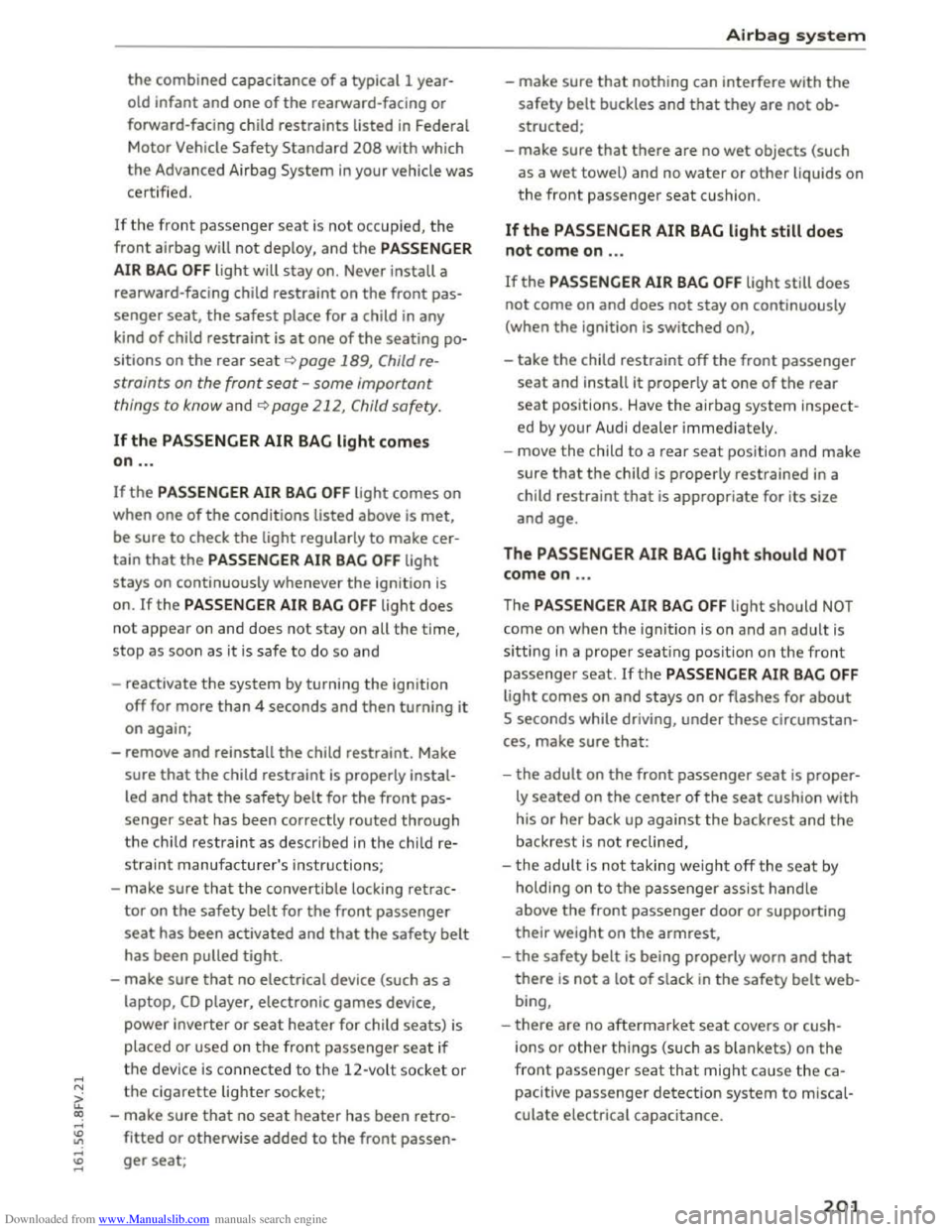
Downloaded from www.Manualslib.com manuals search engine .....
the combined capacitance of a typical l year
old
infant and one of the rearward-facing or
forward-facing child restraints listed in Federal
Motor Vehicle
Safety Standard 208 with which
the Advanced Airbag System in your vehicle was
certified.
If the front passenger seat is not occupied, the
front airbag will not deploy, and the PASSENGER
AIR BAG OFF light will stay on. Never install a
rearward -facing child
restraint on the front pas
senger seat, the safest place for a child in any
kind
of child restraint is at one of the seating po
sitions on
the rear seat ~page 189, Child re
straints on the front
seat -some important
things to know
and ~page 212, Child safety.
If the PASSENGER AIR BAG light comes
on ...
If the PASSENGER AIR BAG OFF light comes on
when one of the conditions listed above is met,
be sure to check the light regularly to make cer
tain that the PASSENGER AIR BAG OFF light
stays on continuously whenever the ignition is
on. If the PASSENGER AIR BAG OFF light does
n
ot appea r on and does not stay on all the time,
stop as soo n as it is safe to do so and
- reactivate
the system by turning the ignition
off for more than 4 seconds and then turning it
on again;
- remove and reinstall
the child restraint. Make
sure that the child restraint is properly instal
led and
that the safety belt for the front pas
senger seat has been correctly routed through
the child restrain t as described in th e child re
straint manufacturer's instructions;
- make
sure that the convertible locking retrac
tor on the safety belt for the front passenger
seat has been activated and that the safety belt
has been pulled tight.
-make sure that no electrical device (such as a
laptop,
CD player, electron ic games device,
power inverter
or seat heater for child seats) is
placed or used on the front passenger seat if
the device is connected to the 12-volt socket or
~ the cigarette lighter socket;
co -make sure that no seat heater has been retro-...
~ fitted or otherwise added to the front passen-
..... :::: ger seat;
Airbag system
-make sure that nothing can interfere with the
safety belt buckles and that they are not ob
structed;
-make sure that there are no wet objects (such
as a wet towel) and no water or other liquids on
the front passenger seat cushion.
If the PASSENGER AIR BAG light still does
not come on ...
If the PASSENGER AIR BAG OFF light still does
not come on and does not stay on continuously
(when
the ignition is switched on),
-
take the child restraint off the front passenger
seat and install it properly at one of the rear
seat positions. Have the airbag system inspect
ed
by your Audi dealer immediately.
-move the child to a rear seat position and make
sure that the child is properl y restrained in a
child
restraint that is appropriate for its size
and age.
The PASSENGER AIR BAG light should NOT
come on ...
The PASSENGER AIR BAG OFF light should NOT
come on when the ignition is on and an adult is
sitting in a prope r seating position on the front
passenger seat. If the PASSENGER AIR BAG OFF
light comes on and stays on or flashes for about
5 seconds while driving, under these circumstan
ces,
make sure that:
-the adult on the front passenger seat is proper
ly seated on the center of the seat cu sh ion wit h
his or
her back up against the backrest and the
backrest is not reclined,
-
the adult is not taking weight off the seat by
holding on to the passenger assist handle
above
the front passenger door or supporting
their weight on the armrest,
-the safety belt is being properly worn and that
there is not a lot of slack in the safety belt web
bing,
-
there are no aftermarket seat covers or cush
ions or
other things (such as blankets) on the
front passenger seat that might cause the ca
pacitive passenger detection system to miscal
culate electrical capacitance.
201
Page 217 of 322
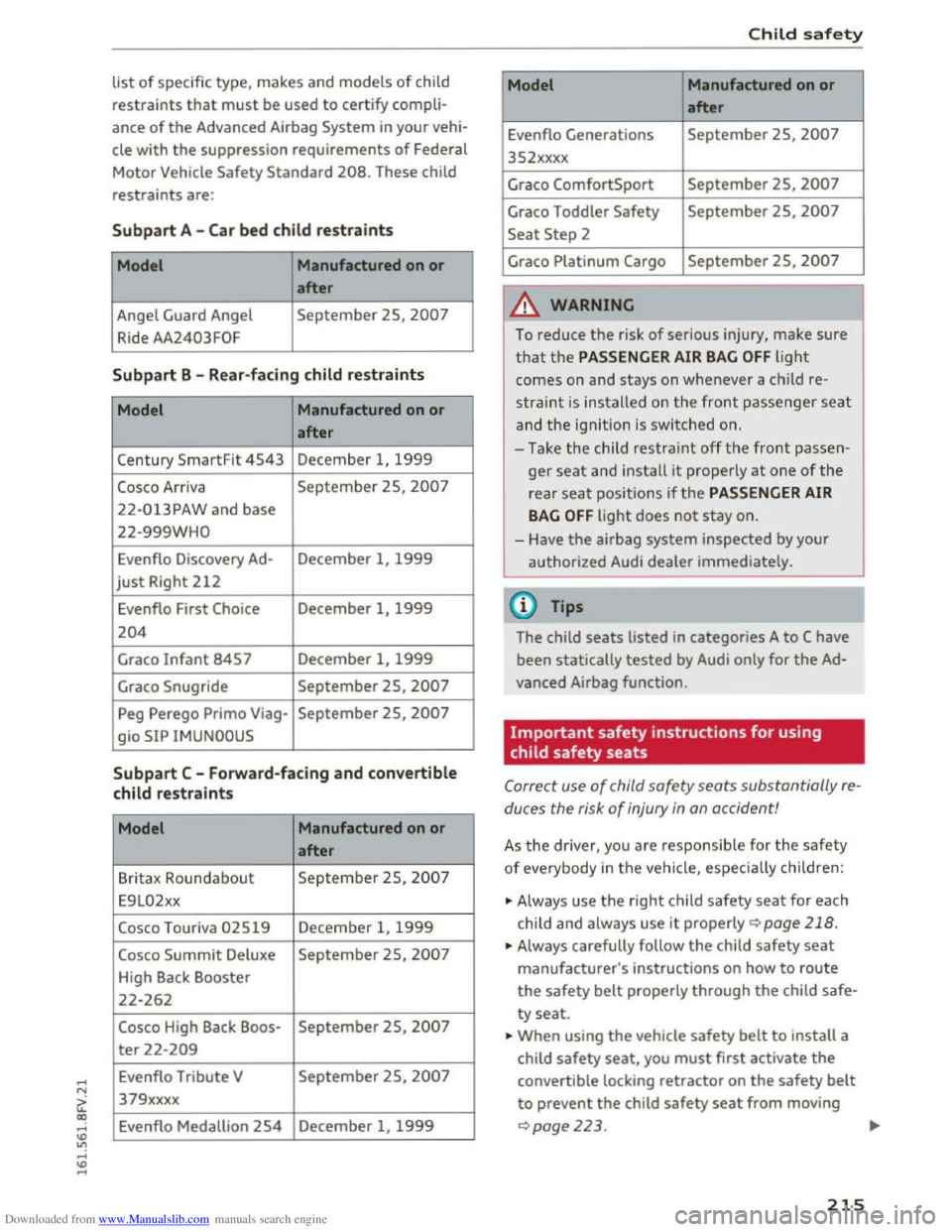
Downloaded from www.Manualslib.com manuals search engine ...... N
> u. CX> ...... u:>
"' ..... u:> .....
list of specific type, makes and models of child
restraints that must be used to certify compli
ance of the Advanced Airbag System in your vehi
cle with the suppression requirements of Federal
Motor Vehicle
Safety Standard 208. These child
restraints are:
Subpart A -Car bed child restraints
Model Manufactured
on or
after
Angel Guard Angel September 25, 2007
Ride AA2403FOF
Subpart B -Rear-facing child restraints
Model Manufactured
on or
after
Century SmartFit 4543 December 1, 1999
Cosco Arriva September 25, 2007
22-013PAW and base
22-999WHO
Evenflo Discovery Ad-December 1, 1999
just Right 212
Evenflo First Choice December 1, 1999
204
Graco Infant 8457 December 1, 1999
Graco Snugride September 25, 2007
Peg Perego Primo Viag-September 25, 2007
gio SIP IMUNOOUS
Subpart C -Forward -facing and convertible
child restraints
Model Manufactured on or
after
Britax Roundabo ut September 25, 2007
E9 L02xx
Cosco Touriva 02519 December 1, 1999
Cosco Summit Deluxe September 2S, 2007
High Back Booster
22-262
Cosco High Back Boos-September 2S, 2007
ter 22-209
Evenflo Tribute V September 25, 2007
379xxxx
Evenflo Medallion
254 December 1, 1999
Child safety
Model Manufactured on or
after
Evenflo Generations September 25, 2007
352xxxx
Graco
ComfortSport September 25, 2007
Graco Toddler Safety September 25, 2007
Seat Step 2
Grace
Platinum Cargo September 25, 2007
A WARNING
i-=--
To reduce the r isk of serious injury, make sure
that the PASSENGER AIR BAG OFF light
comes on and stays on whenever a child re
stra int is installed on the front passenger se a t
and the ignit ion is switched on.
- T ake
the child restraint off th e front passen
ger seat and install it properly at one of the
rear seat positions if the PASSENGER AIR
BAG OFF light does not stay on.
- Have
the airbag system inspected by your
a u
thorized Audi dealer immediately.
been statically tested by Audi only for the Ad
vanced Airbag function.
Important safety instructions for using
child
safety seats
Correct use of child safety seats substantially re
duces
the risk of injury in an accident!
As the driver, you are responsible for the saf e ty
of eve rybody in the vehicle, especially c hildre n:
.,. Always use the right child safety seat for each
child
and always use it properly i:> page 218.
.,. Always carefully follow the child safety seat
manufacturer's instructions on how to route
the safety belt properly through the child safe
ty seat.
.. When using the vehicle safety belt to install a
child
safety seat, you must first activate the
convertible locking retractor on the safety belt
to prevent the child safety seat from moving
i:>page223. Iii>
215
Page 220 of 322

Downloaded from www.Manualslib.com manuals search engine Child safety
as by fastening the unused safety belt be
hind the child seat and letting the belt re
tractor wind up the webbing.
Child seats
Infant seats
Babies and infants up to about one year old and
20 lbs or 9 kg need special rearward-facing child
restraints
that support the back, neck and head
in a crash.
Fig. 166 Schemat ic overview : rearward -facing infant seat,
properly installed on the rear seat
"'When using the veh icle safety belt to install a
child
safety seat, you must first activate the
convertible locking retractor on the safety belt
to prevent the child safety seat from moving
9page 223.
"'Push the child safety seat down with your full
weight to get the safety belt really tight so that
the seat cannot move forward and sideways
more than 1 in (2.5 cm).
"'Secure unused safety belts on the rear seat
9page 217.
Infants up to about one year (20 lbs or 9 kg) are
best protected in specia l infant carriers and child
safety seats designed for their age group. Many
experts believe that infants and small children
should ride only in special restraints in which the
child faces the back of the vehicle. These infant
seats support the baby 's back, neck and head in a
crash 9fig. 166.
The airbag on the passenger side makes the front
seat a potentially dangerous place for a child to
ride. The front seat is not the safest place for a
child
in a forward-facing child seat. It is a very
218
dangerous place for an infant or a larger child in
a rearward-facing seat.
A WARNING
Not using a child safety seat, using the wrong
child safety seat or improperly installing a
child
restraint increases the risk of serious
personal injury and death in a crash.
- Never install rear-facing child
safety seats
or infant carriers on the front passenger
seat -even with an Advanced Airbag System.
A child will be seriously injured and can be
killed when the inflating airbag hits the
child safety seat or infant carrier with great
force and smashes the child safety seat and
child
against the backrest, center armrest,
door or roof~ page 189, Child restraints on
the front seat -some important things to
know.
-Always install rear-facing chi ld safety seats
or infant carriers on the rear seat.
-Never install a rear-facing child restraint in
the forward-facing direction. Such restraints
are designed for the special needs of infants
and very small children and cannot protect
them properly if the seat is forward-facing.
-
If you must install a rearward facing child
safety seat on the front passenger seat be
cause of exceptional circumstances and the
PASSENGER AIR BAG OFF light does not
come on and stay on, immediately install
the rear-facing child safety seat in a rear
seating position and have th e a irbag system
inspected by your Audi dealer.
- Never pl
ace or use any electrical device
(such
as a laptop, CD player, electronic
games d evice, power inverter or seat heater
for child seats) on the front passenger seat
if the device is connected to the 12-volt
socket or the cigare tte lighter socket.
-
If a seat heater has been retrofitted or oth
erwise added to the front passenger seat,
never install any child restraint system on
this seat.
-Make sure that there are no wet objects
(such as a wet towel) and no water or other
liquids on the front passenger seat cushion. ..,.
Page 221 of 322

Downloaded from www.Manualslib.com manuals search engine ..... N
G: CX)
.....
"' U"I
.....
"' .....
-Never place objects on the seat (such as a
laptop, CD player, electronic games device,
power inverter or seat heater for child
seats). These may influence the electrical
capacitance measured by the capacitive pas
senger detection system and can also fly
around in an accident and cause serious per
sonal injury .
- Always
read and heed all WARNINGS when
ever using a child restrained in a veh icle is
being
used r:'.> page 180, Safety belts,
r:'.>page 188, Airbag system and
r:'.>page 212, Important information.
Convertible child safety seats
Properly used convertible child safety seats con
help protect toddlers and children over age one
who weigh between
20 and 40 lbs (9 and 18 kg)
in a crash.
Fig. 167 Schematic overv iew : installat io n of the attach
m
ents applicab le to a LATCH seat
Fig. 168 Sche matic overview: i nstallat io n of t he sea t using
the vehicle 's safety belt syste m
•When using the vehicle safety belt to install a
child
safety seat, you must first activate the
convertible locking retractor on the safety belt
to prevent the child safety seat from moving
Child safety
r:'.>poge 223 or install the seat using the LATCH
attachments.
•Push the child safety seat down with your full
weight to get the safety belt really tight so that
the seat cannot move forward or sideways
more than 1 in (2 .5 cm) r:'.>page 223.
"' If the child safety seat is equipped with a tether
strap, attach it to the tether anchors
r:'.> page 228.
"'Secure unused safety belts on the rear seat
r:'.> page 217.
A toddler or child is usually too large for an in
fant restraint if it is more than one year old and
weighs more than 20 lbs (9 kg).
Toddlers
and children who are older than one
year up to about 4 years old and weigh more than
20 lbs (9 kg) up to 40 lbs (18 kg) must always be
properly
restrained in a child safety seat certified
for
their size and weight r:'.> fig. 167 and
r:'.> fig. 168.
The airbag on the passenger side makes the front
seat a potentially dangerous place for a child to
ride . The front seat is not the safest place for a
child
in a forward -facing child safety seat. It is a
v e
ry dangerous place for an infant or a larger
child in a rearward-facing seat.
_&WARNING
f-=-
Not using a child safety seat, using the wrong
child
safety seat or improperly i nstalling a
child
restraint increases the risk of serious
personal i njury and death in a collision or oth
er emergency situation.
-
Children on the front seat of any car, even
with Advanced Airbags, can be seriously in
jured or even killed when an airbag inflates.
A child in a rearward-facing child safety seat
installed on the front passenger seat will be
seriously injured and can be killed if the
front airbag inflates -even with an Ad
vanced Airbag System.
- The inflating airbag will hit
the child safety
seat or infant carrier with great force and
will smash the child safety seat and child
against the backrest, center arm rest, door
or roof.
219
Page 223 of 322
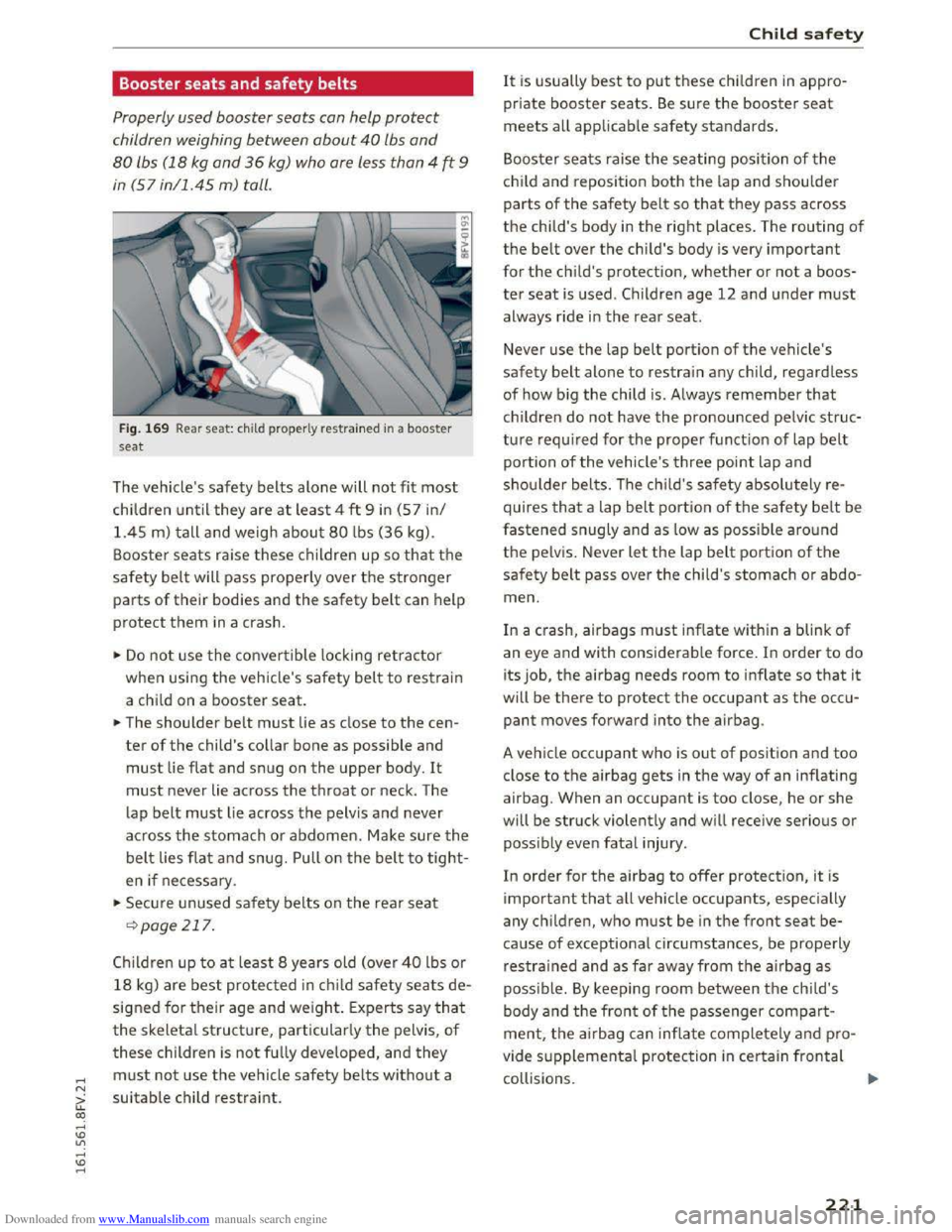
Downloaded from www.Manualslib.com manuals search engine ..... N
G: CX)
..... I.Cl U"I
..... I.Cl .....
Booster seats and safety belts
Properly used booster seats can help protect
children weighing between about 40 lbs and
80 lbs (18 kg and 36 kg) who are less than 4 ft 9
in (57 in/1.45 m) tall.
Fig. 169 Rear seat; chil d properly restrained in a booster
seat
The vehicle's safety belts alone will not fit most
children until they are at least 4 ft 9 in (57 in/
1.45 m) tall and weigh about 80 lbs (36 kg).
Booster
seats raise these children up so that the
safety belt will pass properly over the stronger
parts of their bodies and the safety belt can help
protect them in a crash.
.. Do not use the convertible locking retractor
when using the vehicle's safety belt to restrain
a child on a
booster seat.
.. The shoulder belt must lie as close to the cen
ter of the child's collar bone as possible and
must lie flat and snug on the upper body. It
must never lie across the throat or neck. The
lap
belt must lie across the pelvis and never
across
the stomach or abdomen. Make sure the
belt lies flat and snug. Pull on the belt to tight
en if necessary .
.. Secure unused safety belts on the rear seat
~page 217.
Children up to at least 8 years old (over 40 lbs or
18 kg) are best protected in child safety seats de
signed for their age and weight. Experts say that
the skeletal structure, particularly the pelvis, of
these children is not fully developed, and they
must not use the vehicle safety belts without a
suitable child restraint.
Child safety
It is usually best to put these children in appro
priate booster seats. Be sure the booster seat
meets all applicable safety standards.
Booster seats raise the seating position of the
child and reposition both the lap and shoulder
parts of the safety belt so that they pass across
the child's body in the right places. The routing of
the belt over the child's body is very important
for the child's protection, whether or not a boos
ter seat is used . Children age 12 and under must
always ride in the rear seat.
Never use the lap belt portion of the vehicle's
safety belt alone to restrain any child, regardless
of how big the child is. Always remember that
children do not have the pronounced pelvic struc
ture required for the proper function of lap belt
portion of the vehicle's three point lap and
shoulder belts. The child's safety absolutely re
quires
that a lap belt portion of the safety belt be
fastened snugly and as low as possible around
the pelvis. Never let the lap belt portion of the
safety belt pass over the child's stomach or abdo
men.
In a crash, airbags must inflate within a blink of
an eye and with considerable force. In order to do
its job, the airbag needs room to inflate so that it
will be there to protect the occupant as the occu
pant moves forward into the airbag .
A vehicle
occupant who is out of position and too
close to the airbag gets in the way of an inflating
airbag.
When an occupant is too close , he or she
will be struck violently and will receive serious or
possibly even fatal injury.
In
order for the airbag to offer protection, it is
important that all vehicle occupants, especially
any children,
who must be in the front seat be
cause
of exceptional circumstances, be properly
restrained and as far away from the airbag as
possible. By keeping room between the child's
body
and the front of the passenger compart
ment, the airbag can inflate completely and pro
vide
supplemental protection in certain frontal
collisions .
221
Page 225 of 322
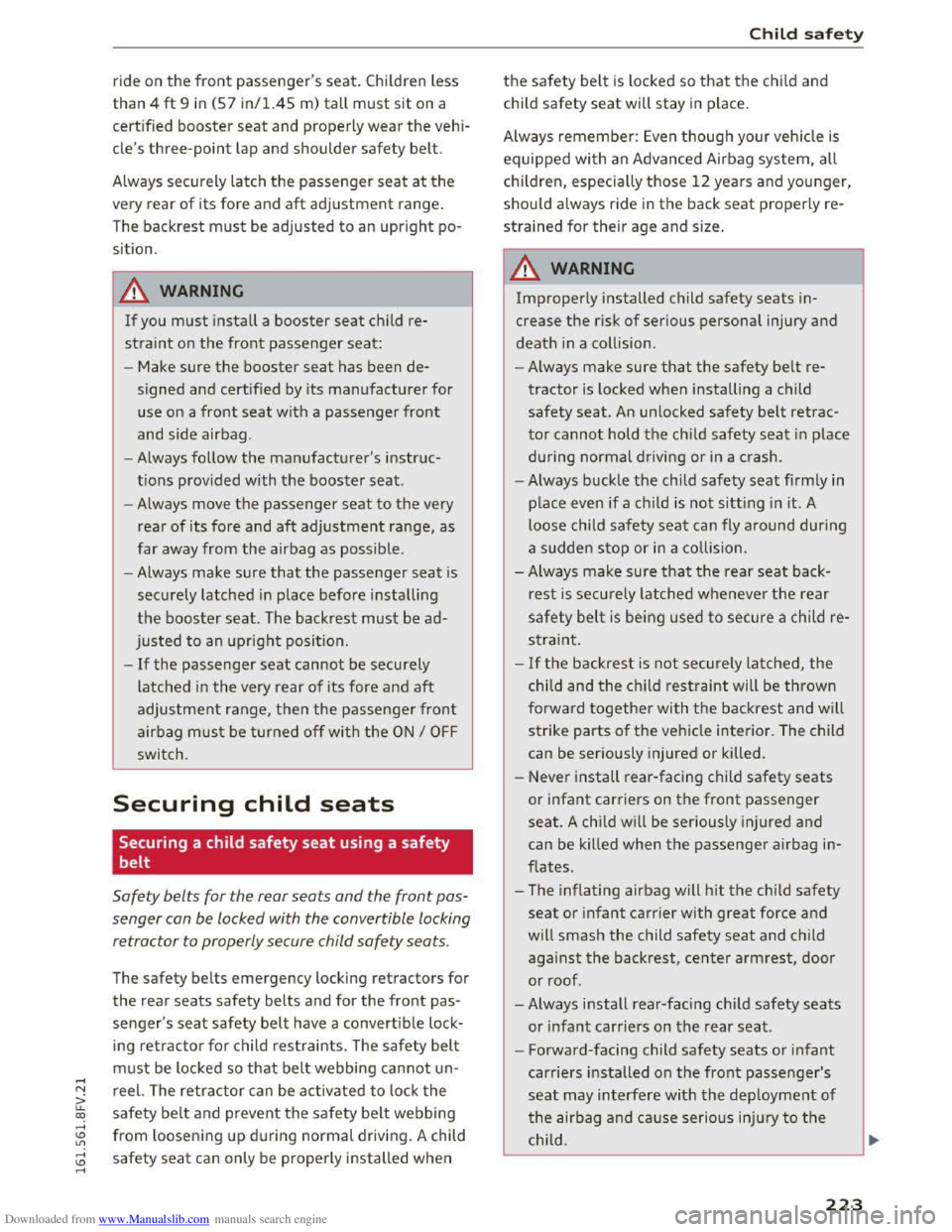
Downloaded from www.Manualslib.com manuals search engine ride on the front passenger's seat. Children less
than 4 ft 9 in (57 in/1.45 m) tall must sit on a
certified booster seat and properly wear the veh i
cle's three-point lap and shoulder safety belt.
Always
securely latch the passenger seat at the
very rear of its fore and aft adjustment range.
The backrest must be adjusted to an upright po
sition .
A WARNING
If you must install a booster seat child re
straint on the front passenger seat:
-Make sure the booster seat has been de
signed and certified by its manufacturer for
use on a front seat with a passenger front
and side airbag.
- Always follow
the manufacturer's instruc
t i
ons prov ided with the booster seat.
-Always move the passenger seat to the very
rear of its fore and aft adjustment range, as
far away from the airbag as possible .
- Always
make sure that the passenger seat is
securely latched in place before installing
the booster seat. The backrest must be ad
justed to an uprig ht position.
-If the passenger seat cannot be securely
latched in the very rear of its fore and aft
adjustment range, then the passenger front
airbag must be turned off with the ON I OFF
switch.
Securing child seats
Securing a child safety seat using a safety
belt
Safety belts for the rear seats and the front pas
senger can be Locked with the convertible Locking
retractor to properly secure child safety seats.
The safety belts emergency locking retractors for
the rear seats safety belts and for the front pas
senger's seat safety belt have a convertible lock
i ng
retractor for child restraints. The safety belt
must be locked so that belt webbing cannot un
reel. The
retractor can be activated to lock the
safety belt and prevent the safety belt webbing
from loosening up during normal driving. A child
safety seat can only be properly installed when
Child safety
the safety belt is locked so that the chi ld and
child safety seat will stay in place .
Always
remember : Even though your veh icle is
equipped with an Advanced Airbag system, all
children, especia lly those 12 years and younger,
should a lways ride in the back seat properly re
strained for their age and size.
A WARNING
Improperly installed child safety seats in
crease the risk of serious personal injury and
death in a collision.
-
- Always make sure that the safety be lt re
tractor is locked when installing a child
safety seat. An unlocked safety belt retrac
tor cannot hold the child safety seat in place
du ring
normal d riving or in a c rash.
-Always buckle the child safety seat firmly in
place even if a ch ild is not sitting in it. A
loose child
safety seat can fly around during
a
sudden stop or in a co llision.
- Always
make sure that the rear seat back
rest is secu rely latched whenever the rear
safety belt is being used to secure a child re
straint.
-
If the backrest is not secu rely latched, the
chi ld and t he child restraint will be thrown
forward together with the backrest and will
strike parts of the vehicle interior. The child
can
be seriously injured or killed.
- Never
install rear-facing child safety seats
or infant carriers on the front passenger
seat. A child w ill be seriously injured and
can be killed when the passenger a irbag in
f lates.
- The inflating airbag will hit the ch ild safety
seat or infant carrier with great force and
will smash the child safety seat and child
against the backrest, center armrest, door
or roof.
-Always install rear-fac ing ch ild safety seats
or infant carriers on the rear seat.
- Forward-facing child
safety seats or infant
carriers installed on the front passenger's
seat may interfere with the deployment of
the airbag and ca use serious injury to the
child.
223
Page 227 of 322
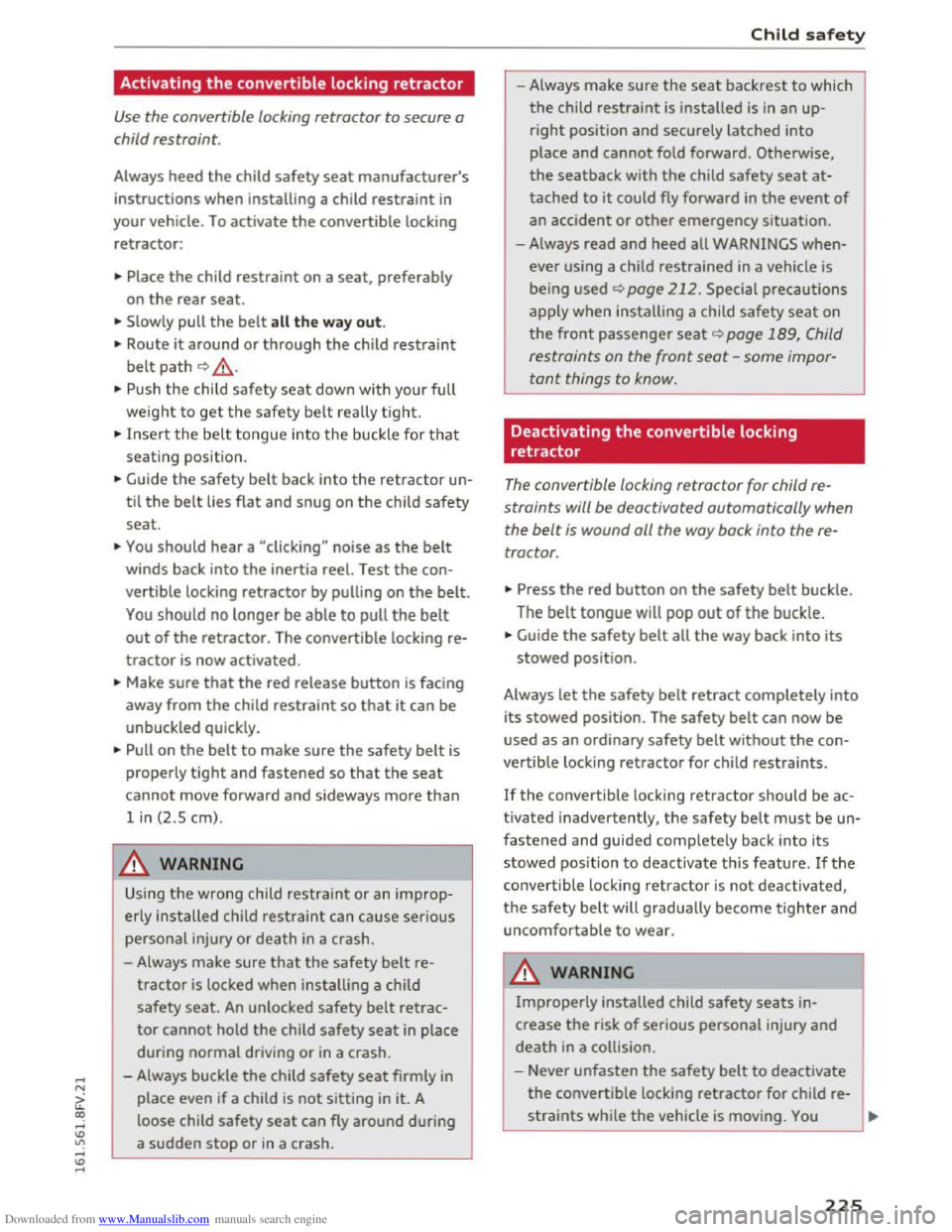
Downloaded from www.Manualslib.com manuals search engine ...... N
G'. CX)
..... ID IJ' ..... ID .....
Activating the convertible locking retractor
Use the convertible locking retractor to secure a
child restraint.
Always heed the child safety seat manufacturer's
instructions when installing a child restraint in
your vehicle. To activate the convertible locking
retractor:
.. Place the child restraint on a seat, preferably
on the rear seat.
.. Slowly pull the belt all the way out.
.. Route it around or through the child restraint
belt path <:!> .&,..
"'Push the child safety seat down with your full
weight to get the safety belt really tight.
.. Insert the belt tongue into the buckle for that
seating position .
.. Guide the safety belt back into the retractor un
til
the belt lies flat and snug on the child safety
seat.
.. You should hear a "clicking" noise as the belt
winds back into the inertia reel. Test the con
vertible locking retractor by pulling on the belt.
You should no longer be able to pull the belt
out of the retractor. The convertible locking re
tractor is now activated .
.. Make sure that the red release button is facing
away from
the child restraint so that it can be
unbuckled quickly.
.. Pull on the belt to make sure the safety belt is
properly
tight and fastened so that the seat
cannot move forward and sideways more than
1 in (2.S cm).
.&_WARNING
Usi ng the wrong child restraint or an improp
erly installed child restraint can cause serious
personal injury or death in a crash.
- Always
make sure that the safety belt re
tractor is locked when installing a child
safety seat. An unlocked safety belt retrac
tor cannot hold the child safety seat in place
during
normal driving or in a crash.
- Always buckle
the child safety seat firmly in
place even if a child is not sitting in it. A
loose child safety seat can fly around during
a
sudden stop or in a crash.
Child safety
- Always make sure the seat backrest to which
the child restraint is installed is in an up
right position and securely latched into
place and cannot fold forward. Otherwise,
the seatback with the child safety seat at
tached to it could fly forward in the event of
an accident or other emergency situation.
-Always read and heed all WARNINGS when
ever using a child restrained in a vehicle is
being
used <:!>page 212. Special precautions
apply when installing a child safety seat on
the front passenger seat <:!>page 189, Child
restraints on the front seat-some impor
tant things to know.
Deactivating the convertible locking
retractor
The convertible locking retractor for child re
straints will be deactivated automatically when
the
belt is wound all the way back into the re
tractor.
.. Press the red button on the safety belt buckle.
The
belt tongue will pop out of the buckle.
.. Guide the safety belt all the way back into its
stowed position.
Always
let the safety belt retract completely into
its stowed position. The safety belt can now be
used as an ordinary safety belt without the con
vertible locking retractor for child restraints.
If the convertible locking retractor should be ac
tivated inadvertently, the safety belt must be un
fastened and guided completely back into its
stowed position to deactivate this feature. If the
convertible locking retractor is not deactivated,
the safety belt will gradually become tighter and
uncomfortable to wear.
.&. WARNING
Improperly installed child safety seats in
crease the risk of serious personal injury and
death in a collision.
----'
- Never unfasten the safety belt to deactivate
the convertible locking retractor for child re
straints while the vehicle is moving. You
225
Page 230 of 322
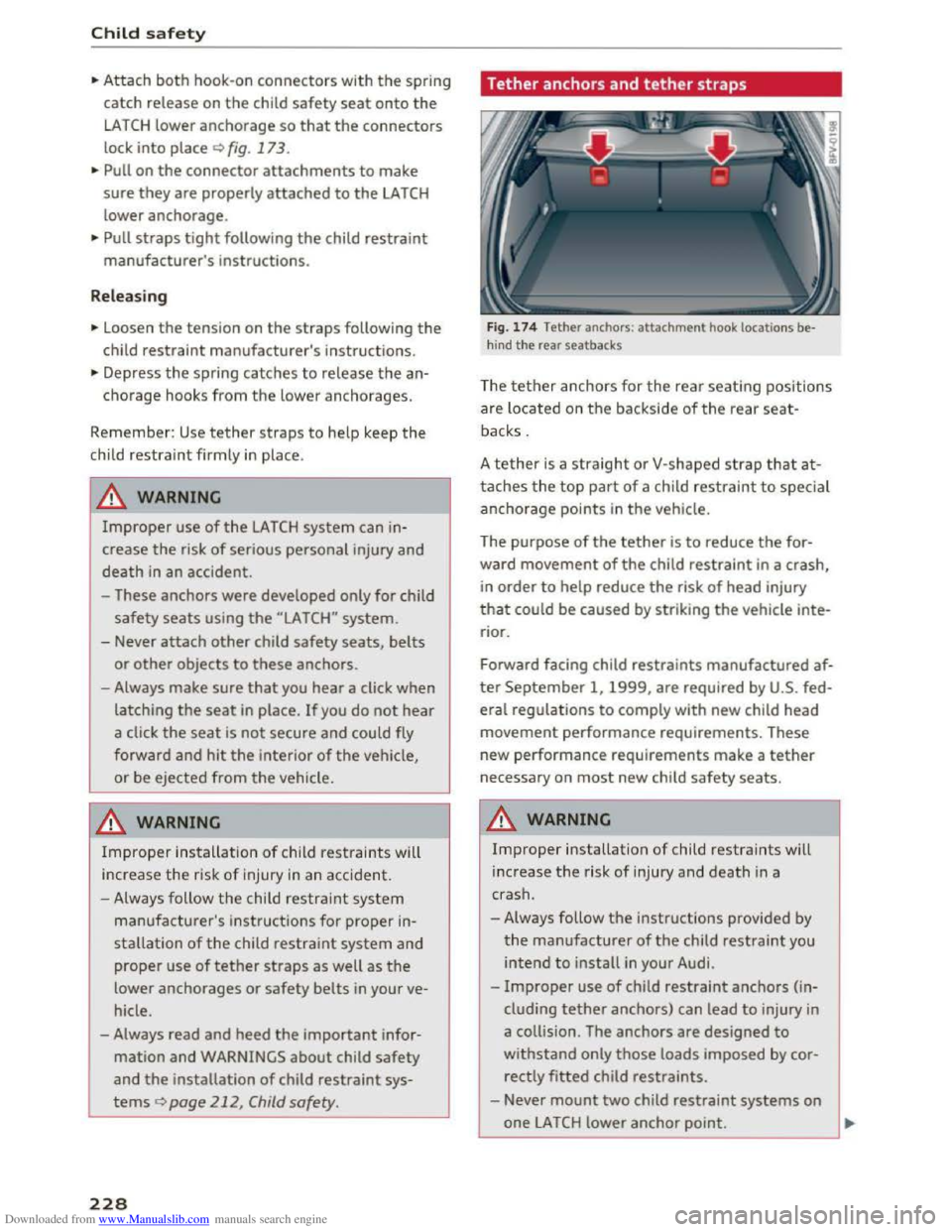
Downloaded from www.Manualslib.com manuals search engine Child safety
•Attach both hook-on connectors with the spring
catch release on the child safety seat onto the
LATCH lower anchorage so that the connectors
lock into place Q fig. 173.
• Pull on the connector attachments to make
sure they are properly attached to the LATCH
lower anchorage.
• Pull straps tight following the child restraint
manufacturer's instructions.
Releasing
• Loosen the tension on the straps following the
child restraint manufacturer's instructions.
• Depress the spring catches to release the an
chorage hooks from the lower anchorages.
Remember: Use tether straps to help keep the
child restraint fir m ly in place .
A WARNING
Improper use of the LATCH system can in
crease the risk of serious personal injury and
death in an accident.
- These
anchors were developed only for child
safety seats using the "LATCH" system.
-Never attach other child safety seats, belts
or other objects to these anchors.
- Always
make sure that you hear a click when
la tching
the seat in place. If you do not hear
a click the seat is not secure and could fly
forward
and hit the interior of the vehicle,
or be ejected from the vehicle.
A WARNING
Improper installation of c hild restraints will
increase
the risk of i njury in an accident.
-Always follow the child restraint system
manufacturer's instructions for proper in
stallation of the child restraint system and
proper use of tether straps as well as the
lower anchorages or safety belts in your ve
hicle.
- Always read and
heed the important infor
mation and WARNINGS about child safety
and the installation of child restraint sys
tems Q page 212, Child safety.
228
Tether anchors and tether straps
Fig. 174 Tether anchors : attachment hook locations be·
hind th e rear seatbacks
The tether anchors for the rear seating positions
are located on the backside of the rear seat·
backs.
A
tether is a straight or V-shaped strap that at
taches the top part of a child restraint to special
anchorage points in the vehicle.
The
purpose of the tether is to reduce the for
ward movement of the child restraint in a crash,
in order to help reduce the risk of head injury
that could be caused by striking the vehicle inte
rior.
Forward facing child
restraints manufactured af
ter September 1, 1999, are required by U.S. fed
eral regulations to comply with new child head
movement performance requirements. These
new
performance requirements make a tether
necessary on most new child safety seats.
A WARNING
Improper installation of child restraints will
increase
the risk of injury and death in a
crash.
-Always follow the instructions provided by
the manufacturer of the child restraint you
intend to install in your Audi.
-
Improper use of child restraint anchors (in
cluding tether anchors) can lead to injury in
a collision. The anchors are designed to
withstand only those loads imposed by cor
rectly fitted child restraints.
-Never mount two child restraint systems on
-
one LATCH lower anchor point. ..,.